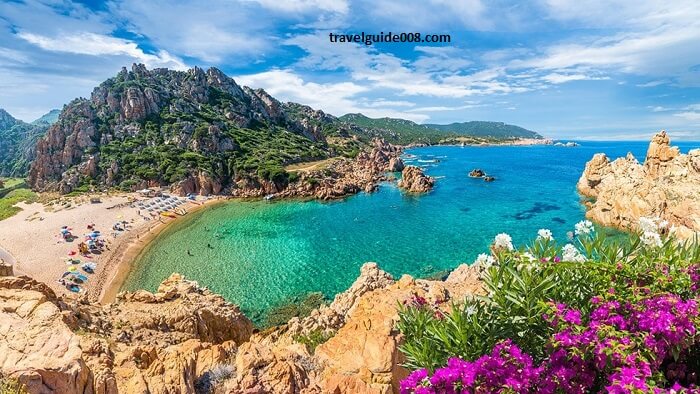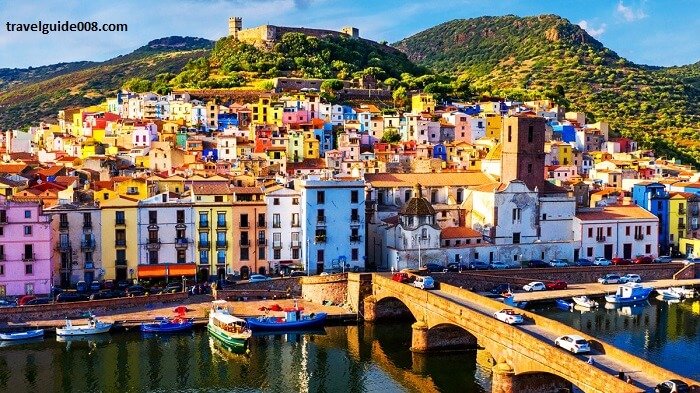Sardinia Travel Guide:
Unveiling the Jewel of the Mediterranean Located in the Mediterranean Sea, Sardinia is an island country characterized by amazing coastlines, very rugged mountains, and a significant cultural heritage. With its waters of turquoise colors, wonderful beaches, and varied landscapes, Sardinia remains a dream destination for the traveler who desires both rest and adventure. This travel guide will discover everything you need to know to have the best of your journey to this enchanted island.

Getting There:
Travel Guide:
Sardinia is well-covered by many air and sea lines. The island is reached through three main airports: Cagliari Elmas Airport (CAG), Olbia Costa Smeralda Airport (OLB), and Alghero Fertilia Airport (AHO ). Many airlines offer direct routes from European cities so the territory does not pose any obstacle while traveling from abroad. Otherwise, if you want to use the scenery along your line, you might take pleasure in ferries from major Italy (Genoa, Livorno, and Civitavecchia) which possibly will be a wonderful lead into your trip.
Best Time to Visit:
Travel Guide:
The best time to visit Sardinia is during the shoulder seasons of spring (April to June) and early autumn (September to October). The climate is pleasantly warm during these months, fewer crowds are present, and the prices for accommodations and activities are generally lower. July and August are the peak tourist months, particularly in coastal areas, and you can expect crowded beaches and higher prices.
Where to Stay:
Travel Guide:
Sardinia also provides luxury resorts and cottage agriturismos, farm stays that offer an interesting and cozy experience. Some of the popular areas to consider are:
Cagliari:
Travel Guide:
Cagliari, the capital city, is a mix of history and modern comforts. Visit this place to stroll along the historic Castello district, play on Poetto Beach, and dance all night. You may prefer Hotel Regina Margherita and T Hotel, comfortable accommodations in the heart of the city.
Costa Smeralda:
Travel Guide:
Famous for its glamorous beaches and exclusive resorts, Costa Smeralda is one location not to miss when looking for luxury. The town offers high-class hotels, haute cuisine, and vibrant nightlife. Two famous resorts in the area include Hotel Cala di Volpe and the Cervo Hotel.
Alghero:
Travel Guide:
Steeped in Catalan influence and boasting an incredible coastline, this charming town on the northwest coast is a historic center that abounds in narrow cobblestone streets and lively piazzas, dominated by beautiful churches that seem to touch the sky. Convenient stays can be had in accommodations like Hotel Catalunya and Villa Piras with beaches easily within reach.
Oristano:
Travel Guide:
The main reason to stay in Oristano is if you want a more authentic experience of Sardinia; this lesser-known area holds a lot of history with a more laid-back feeling. Agriturismo Sa Ruda is one of the popular agritourism for the experience of rural life.

Top Attractions:
Travel Guide:
Beaches
Sardinia is famed for its amazing beaches-many and some of the best in the world. Below is a list of must-visit beaches:
La Pelosa Beach (Stintino):
La Pelosa shines due to its white shores and shallow, crystal clear waters ideal for the family and with a fantastic vista of the nearby Asinara Island.
Cala Goloritzé:
To get here, one can either go on foot or by boat, making this beach a true secret gem. This is nature’s haven where one finds extraordinary rock formations and turquoise-colored water; a treasure in store for fans of nature.
Spiaggia di Tuerredda is one of Italy’s most beautiful beaches. It can be found near Teulada, with white sand and the bright colors of the sea.
Nuraghe Su Nuraxi:
Travel Guide:
One of the most important archaeological sites in Sardinia, located in Barumini, is Nuraghe Su Nuraxi; this is a UNESCO World Heritage Site. It’s an ancient megalithic monument from the Bronze Age, really interesting to visit, and it says a lot about the prehistoric culture of the island.
Grotte di Neptune:
Travel Guide:
Visitors can reach these beautiful sea caves either by boat or via a 654-step staircase. Inside are impressive stalactites and stalagmites, along with magnificent views of the Mediterranean Sea.
Maddalena Archipelago National Park:
Travel Guide:
A paradise for nature enthusiasts, this national park boasts several islands and islets, which are known as the most beautiful and clean islands with crystal-clear waters around the world. Enjoy explorations by boat, hideaway swimming coves, or hike the trails on the La Maddalena island for breathtaking views.
Recreational Outdoor Activities:
Sardinia provides multiple outdoor activities for adventurous individuals :
Hiking
The island is characterized by hiking trails, easy walks along the coast, and challenging treks in the mountainous interior. Europe’s deepest gorge is the Gorropu Gorge, a place for a hike that has rewarded numerous trekkers with outstanding views.
Watersports:
It’s a paradise for watersport enthusiasts with its blue waters. Snorkel, scuba dive, windsurf, or kitesurf. Beaches such as Porto Pollo and Capo Testa are the favorites.
Cycling:
One can explore all the diverse landscapes of the island through cycling. Along the coast, cycling is good fun, while taking the bike into the hills will make you encounter unique views and local wildlife encounters.
Gastronomic Specialties:
Sardinian dishes symbolize the island’s tremendous cultural and historical heritage. For instance, try :
Porceddu :
It is a slow-roasted suckling pig, often made with myrtle and found in celebratory events.
Culurgiones: This traditional stuffed pasta was mainly made of potatoes, mint, and cheese while being paired with tomato sauce.
Pane Carasau: An extremely thin crispy flatbread that is sort of ‘pan de casa’ among the Sardinians-good for snacking or accompaniment.
Mirto:
A robust, traditional liqueur with myrtle berries, always served as a digestif.
To live a Sardinian experience, dinner at an agriturismo, where you have the opportunity to taste what is prepared with fresh products from the region.
Culture:
Sardinia lives in tradition and culture. Do not miss the immersion in local customs:
Feasts;
There are various festivals held in Sardinia throughout the year, all of which are a blend of religious celebrations and regional traditions. One of these festivals is Cavalcata Sarda in Sassari, where colorful parades of traditional costumes and equestrian displays are performed in May. Another one is the Sant’Efisio Festival in Cagliari, which is a religious procession held early in May.
Crafts and Artisans:
Traditionally, Sardinia has many handicrafts; it’s a land with weaving, ceramics, and jewelry. You can buy something there as a souvenir for the local artists. Visit the artisan shops in the towns like Oristano and Nuoro.
Practical Tips:
Transportation
Renting a car is the best mode of getting around Sardinia, since public transportation may be very infrequent, particularly in rural areas. Be sure to make a reservation beforehand if you are visiting during peak season.
Language:
The official language is Italian, but people also use Sardinian, which is a completely different language with different dialects. Everywhere in tourist areas, people use English, but it would be appreciated if one could at least know some basic phrases in Italian.

Currency:
The Euro (€) is the currency used in Sardinia. Credit cards are accepted everywhere, but always advisable to carry some cash for the smaller places and markets.